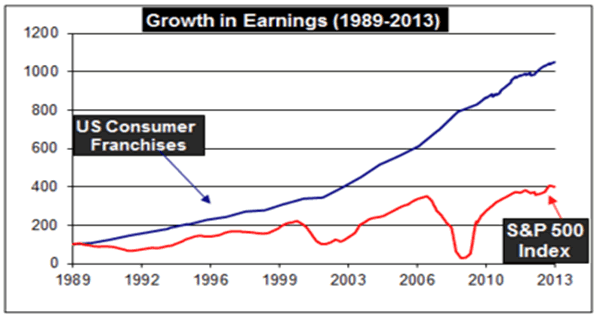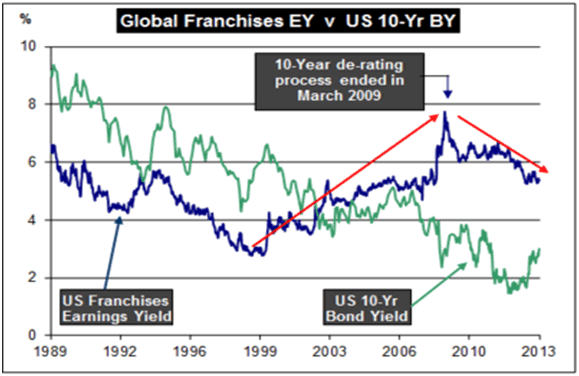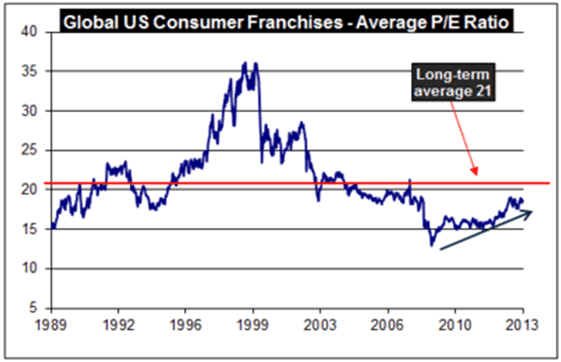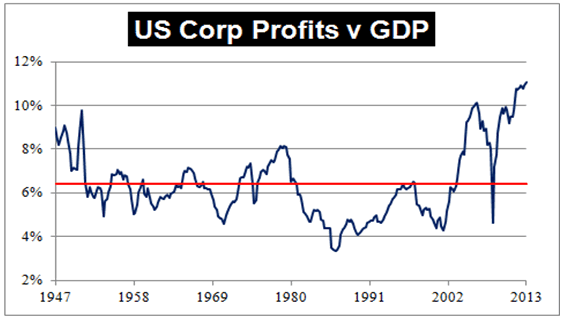US Global Defensive Consumer Franchises Stock Investing Theme
Companies / Sector Analysis Feb 06, 2014 - 01:07 PM GMTBy: Rory_Gillen

 Having your cake and eating it too!
Having your cake and eating it too!
Sometimes you can have your cake and eat it! In investing that means buying stocks with good defensive growth characteristics. In May 2010, GillenMarkets introduced the US Global Defensive Consumer Franchise Theme for subscribers and the theme included eight US companies at that time—Coca Cola, McDonalds, Proctor & Gamble, Colgate, Johnson & Johnson, Wal-Mart, Kellogg and Kraft. The European equivalents—Unilever, Diageo, Reckitt Benckiser and Kerry—were added to the theme in 2011. Kraft has since de-merged and we have substituted Mondelez (the spin off from Kraft) in Kraft's place.
The aim of this theme has been to offer subscribers a lower-risk way of obtaining the returns on offer from markets over time by owning a portfolio of stocks that are global brands, financially strong, have a history of delivering growth and are defensive in recession. This note is an update on the progress of the theme, and the first chart tells the story well.
Earnings Resilience
Since 1988, the earnings of these eight US global defensive consumer franchise stocks (blue line) have been uninterrupted, in aggregate. That is, the collective earnings of these eight companies never declined in any single year since 1988. While individual companies in the theme experienced a decline in earnings from time to time, collectively their earnings continued their upward march, and at a steady pace. Over this 24-year timeline, earnings at these eight companies grew at 9.9% compound per annum.

In contrast, earnings at the 500 companies making up the S&P 500 Index have grown at a lower 5.7% compound per annum rate over the same 1989 to 2013 timeline, and the progress of those earnings was erratic. Most companies are cyclical and their earnings decline in recessions. On three separate occasions, earnings for the S&P 500 declined—in the 1991 recession, the 2001-03 recession, and the 2007-09 global credit crisis.
In other words, the eight stocks I chose for the Global Defensive Consumer Franchise Stock Theme in May 2010 all had special characteristics. They had a competitive advantage of one sort or another, global reach, and demand resilience. The list was not an exclusive one. There are other stocks with these characteristics, but a list of eight provided sufficient diversification.
The competitive advantages that these companies possess—more than anything else—is strong branding and global distribution. Through high quality manufacturing, persistent advertising and/or cost competitiveness, each of these eight companies has managed to bring to market a suite of products that the consuming public are convinced (rightly or wrongly) are the best products available. In some cases, consumers are prepared to pay premium prices for the respective company’s products, which provide these companies with higher margins and returns on capital employed. In other cases, such as Wal-Mart and McDonald’s, a superior offering may be driven by low prices, which results in growing market share. The positioning of each company in its relative market is so strong that words like ‘Coke’, ‘Kellogg’, and ‘McDonald’s’ have become synonymous with soft drinks, convenience food and fast food. This achievement has several advantages:
- Firstly, consumers will choose these companies before any other;
- The companies can pass on increasing input costs to their consumers who are relatively price insensitive and will choose to buy these consumer goods anyway.
- In recessionary environments, these products are positioned in people’s lives such that consumers either cannot do without them (essentials) or would really rather not do without them (essential luxuries). The relatively small prices of their products and the repeat (almost daily) nature of consumer purchases of their products means that demand rarely declines even in recessionary times.
Global distribution is another weapon in most of their armouries. Many of these companies already have the infrastructure in place to take advantage of the growing middle classes incomes in the developing world—particularly in China, India, Asia, Latin America and, more recently, Africa.
Growth in earnings for the US global consumer franchise stocks since the theme was introduced in May 2010 has been 6% compound per annum, against 13% for the S&P 500. Earnings for companies in the S&P 500 were still recovering from cyclically depressed levels in 2010, 2011 and 2012. But over the long-haul, it is the defensive US global consumer franchise stocks that have delivered the better growth and with more consistency, as the earlier chart highlights.
Better Value than Government Bonds
As their earnings are so consistent, the US global defensive consumer franchise stocks can more easily be compared to the (guaranteed) income available from government bonds.

The next chart shows the earnings yield (blue line) this portfolio of eight stocks from the start of 1989 to the end of 2013. The earnings yield represents the amount of earnings you have bought at the current share prices. For example, if Coca Cola is expected to have earned $2.10 a share in 2013 and you buy the shares today at $40, then you are buying an earnings yield of 5.25% ($2.10 / $40* 100= 5.25%).
The historic earnings yield available from these eight companies at the end of December 2013 was 5.3%. The yield available from the US 10-year government bond was 3.0%. Yet, the earnings yield can be expected to grow in the years ahead as these global defensive franchise stocks generate growth by introducing new products, expanding into new regions and, in some cases, buying back shares.
As the chart highlights, in late 1999 the earnings yield available from this portfolio of stocks was circa 3%. At that same time, the risk-free US 10-year bond was offering a yield of over 6%. In late 1999, the value was in the US bonds, and not in these stocks. Today, however, the value continues to reside in these stocks, and by a wide margin. In other words, relative to the value on offer in the main alternative asset class, US long-dated bonds, the US global defensive consumer franchise stocks still offer good value.
Not Overvalued Relative to History
Lastly, it is worth revisiting how these stocks are valued today relative to how investors have valued them in the past.
The next chart highlights that investors have, on average, paid 21 times the earnings of these stocks since late 1988.

Currently, investors are paying 18.6 times historic earnings for these companies. This is still below the long-term average.
For 2013, earnings per share for the S&P 500 are expected to come in at $96.40. At the current index level of 1,848, investors are paying 19.2 times earnings for the S&P 500.
The next chart (taken from the Federal Reserve Economic Database) displays the after-tax corporate profits of US businesses and expresses them as a percentage of GDP.

Currently, US corporate profits are 11% of GDP, some 4.6% above the long-term trend of 6.4%. The chart indicates that, historically, any time profits have moved past 7-8% of GDP, they have reverted back to (and often below) the long-term average.
Today, US corporate profits are at their highest point in 66 years, suggesting that there remains a risk that corporate earnings in the US could, once again, revert to the mean, and downwards. This suggests that S&P earnings are similarly at risk of a mean reversion in margins. However, one cannot make the same argument that earnings at the US global defensive consumer franchises are at similar risk.
The question must then be asked: why would an investor own the S&P 500 (via an exchange-traded fund or otherwise), which is composed of businesses with a higher risk to current earning in the coming years yet which trade at over 19 times those earnings, when he could own a portfolio of global defensive consumer franchise stocks with better earnings resilience and which are on offer at a slightly lower 18.6 times earnings?
Investors may be prepared to pay more today for the earnings of the S&P 500 on the basis that earnings for the index are expected to grow strongly in 2014. However, history suggests that over the long-haul earnings at the S&P 500 have not outpaced those of the US global consumer franchise stocks. I, therefore, find it odd that investors are currently paying more for the earnings of the S&P 500.
In all, I see little valuation risk in the US global defensive consumer franchise stocks either in terms of:
- How investors have valued them in the past;
- The alternative value on offer in US 10-year bonds; or,
- The alternative value on offer in the S&P 500 Index.
Since May 2010, the eight US global defensive consumer franchise stocks have gained circa 45% on average (excluding dividends). Over the same period, the S&P 500 Index has advanced 65%. Nonetheless, the theme remains a low-risk one and it is my view that these giant consumer stocks can continue to deliver annual returns of perhaps 7-8% from here including dividend income.
Rory Gillen
GillenMarkets.com
Rory is the founder of GillenMarkets.com and the author of 3 Steps to Investment Success along with being a regular contributor to the media on issues affecting the financial services industry. He is a qualified Chartered Accountant, a former senior fund manager with Eagle Star, Ireland (now Zurich Ire.) and a co-founder of Merrion Capital in 2000 where he was Head of Equity Research among other roles for several years. In all, he has spent over twenty five years working in the financial services industry. He founded GillenMarkets (www.gillenmarkets.com) in 2005 as a stock market training company and obtained approval from the Central Bank of Ireland to provide investment advice in 2009.
© 2014 Copyright GillenMarkets - All Rights Reserved
Disclaimer: The above is a matter of opinion provided for general information purposes only and is not intended as investment advice. Information and analysis above are derived from sources and utilising methods believed to be reliable, but we cannot accept responsibility for any losses you may incur as a result of this analysis. Individuals should consult with their personal financial advisors.
© 2005-2022 http://www.MarketOracle.co.uk - The Market Oracle is a FREE Daily Financial Markets Analysis & Forecasting online publication.


